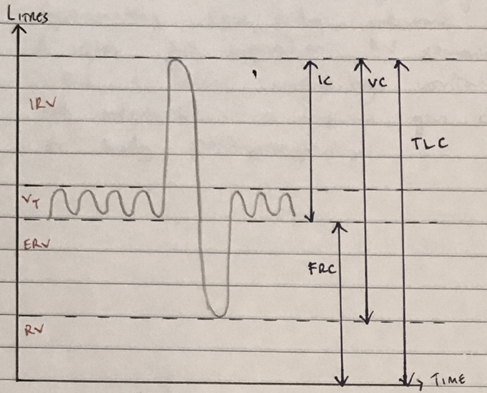F4i / 17B18: Spirometry
17B18: Exam Report
Draw and numerically label, on a spirogram, the lung volumes and capacities of a 30 kg child.
87% of candidates passed this question.
This core respiratory physiology topic was well answered by most candidates. Candidates generally were able to draw a spirogram. A common omission was inspiratory capacity.
Volume
Definition
mL/kg
VT
Volume of air inspired & expired with a normal breath
7mL/kg
IRV
Volume of air which can be inspired over & above VT when the subject inspires at full force
45mL/kg
ERV
Maximum volume of air which can be expired with forceful expiration at the end of VT
15mL/kg
RV
Volume remaining in lungs after forceful expiration
15mL/kg
VC
IRV + VT + ERV
The maximum amount of air which can be expired after forced inspiration
67mL/kg
IC
IRV + VT
Amount of air that can be breathed in at full inspiration
52mL/kg
FRC
ERV + RV
The amount of air left in the lungs at the end of normal VT
30mL/kg
TLC
Volume of gas in lungs at end of maximal forced inspiration
82mL/kg
- Pulmonary gas transport depends on the filling capacity of the lungs
- Markers of lung filling are volumes
- >2 volumes are capacities
- Measured non-invasively by spirometry
- Flow rates & volumes are measured by connecting a spirometry sensor through a mouthpiece
- Subject takes a normal tidal volume & then maximum inspiration, followed by maximum expiration, then returns to tidal ventilation
- Recording of the test is taken as a:
- Forced spirogram (volume vs time)
- Flow volume loop (flow vs volume)
- FVC and FEV1 are the most commonly derived, but you can derive dozens of parameters
- Spirometry can only measure expired gas & after full expiration RV remains in the lungs
- ∴RV & any capacity containing it cannot be measured → requires gas dilution methods or body plethysmography
- Author: Krisoula Zahariou
